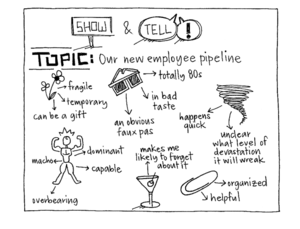
Show and Tell
Show and Tell taps into the power of metaphors to reveal players’ underlying assumptions and associations around a topic
The aim of the game is to get a deeper understanding of stakeholders’ perspectives on anything—a new project, an organizational restructuring, a shift in the company’s vision or team dynamic.
Goal
To get a deeper understanding of stakeholders’ perspectives on anything
Instructions
Preparation
A few days in advance of a meeting, ask employees to bring an artifact for Show and Tell. The instructions are to bring something that, from their perspective, is representative of the topic at hand. If possible, tell them to keep the item hidden until it’s their turn to show it at the meeting.
Flow
- In a white space visible to everyone, write the name of the game and the topic. If you wish, draw a picture of either.
- When everyone is assembled with their show piece, ask for volunteers to stand up and show first.
- Pay close attention to each employee’s story of why she thought an item represented or reminded her of the topic. Listen for similarities, differences, and emotional descriptions of the item. Write each of these contributions in the white space and draw a simple visual of the item the person brought next to her comments.
- Summarize what you’ve captured in the white space and let the group absorb any shared themes of excitement, doubt or concern. Ask follow-up questions about the content to generate further conversation.
Note: As the team lead, encourage and applaud honesty during the stories and write down every point an employee makes that seems important to him or her. Keep the rest of the group quiet while someone is showing and telling. Show and Tell can be a vulnerable activity for employees—particularly the introverted type—so show some team spirit by being vulnerable in your leadership role.
Background
Source: Gamestorming



Comments (0) (5.0 avg / 1 ratings)